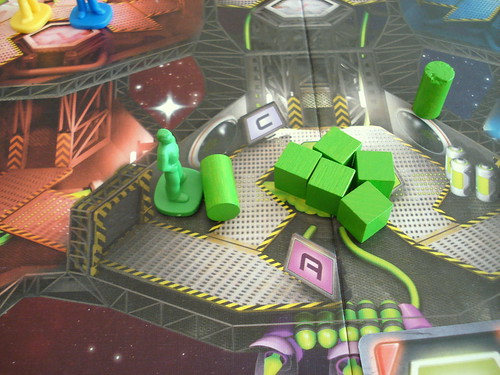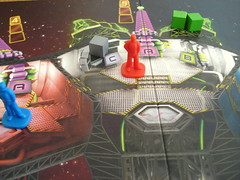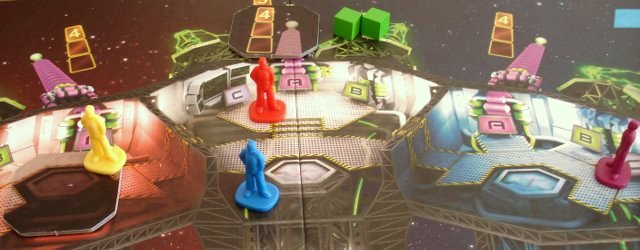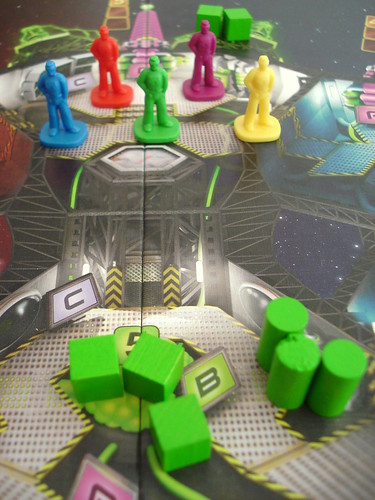| Strategy | Luck |
|---|---|
| Interaction | Components & Design |
| Complexity | Score |
There was a time, not so long ago in fact, when board games were considered a relaxing affair, a hobby to
“Alert! Attack in sector Red! Collision immi…”. A fist slammed down on one of the buttons on the console, silencing the klaxons and the mechanic voice.
Back then, the only thing keeping you from considering every option and taking your sweet time with your move was the angry glares of your fellow player and the occasional thrown
“Malfunction in communication subsystem detected. *krrrrrrrrrrrrrrrrccccccccchhhhttt* Bypassing main communication relais. *krrrrrrrcht*”. Again the gloved fist slammed down impatiently, hitting the same button as before and a couple of innocently bystanding buttons. The computer voice and the static stopped.
And if that is the way you enjoy your board games, then you might as well
“Intruder Alert! Intruder Alert! Unidentified lifeform in sector…”. “Oh for Pluto’s sake! Is this absolutely necessary right now? C omputer, interrupt simulation mode.” The computer voice died down, the red light on the bridge was replaced by proper white illumination.
Combining board games with electronic media is not a new idea: there was a variant of Clue including a video tape back when VHS was considered state of the art. When looking up media-enhanced games for this review, I discovered that only a year after that a honest-to-god video tape variant of Candyland was published. And 10 years later, in 1995, Atmosfear hit the store shelves, advertised enough that I remember being annoyed by the TV spots back then. Some of those games had their proponents, but none can be said to have taken the world by storm and some were downright abysmal. In general, games that require a video tape, CD or DVD are considered too gimmicky by gamers and only really marketed to kids or to fans of TV shows. To say the least, making a game that relies on a track from a CD playing as an essential component was a risky move on the part of designer Vlaada Chvátil and Czech Games Edition.
Space Alert is – raise your hand if this surprises you – a science fiction game. The players in this coop game – we do love coops, did I mention that? – are the crew of a research vessel sent out to remote sectors of the galaxy to cartograph the area. They don’t even need to be there, really; the computer does all the work. The computer gets the ship into position, takes ten minutes to scan the sector – incidentally, that is also the length of one track on the CD – , and then engages the warp drive to go to the next mission. There is no human interaction required or even possible, everything happens on schedule while the crew sit back and drink coffee. That’s it, end of game. Or it would be, if space was as empty as your science teacher tried to make you believe. But since it isn’t, the very first thing you hear on arriving in a new sector (starting the CD) is the computer blaring at you about hostile activities.
From that point on, the relaxed evening with games is over; now you have to survive the next ten minutes while the rest of the universe tries to prevent exactly that. At random intervals, the computer will call out that a new threat appears, which sector of the ship is threatened – red, white or blue from left to right – , and on what turn the threat appears. While the CD is running, everything that happens is planning only: the computer tells you what will happen and when, but nothing is seriously trying to kill you. Yet …

To defend yourself you run around the ship like a bunch of headless chicken and punch at buttons almost randomly, at least in the first few games. Veterans of RoboRally will feel familiar with how that works: everyone plans their actions by playing cards in front of them, determining what their astromeeple will do when the planning is over and the action plays out. Your cards will let you do relatively few things: move one sector towards the left of right, use the elevator between upper and lower deck in the sector you are in or use one of the ship’s systems at your current location. Two things make Space Alert even more exasperating than RoboRally: the alert messages from the computer and the attempt to coordinate with the other players to save the ship instead of simply pushing them down a hole.
When planning out your moves there is a lot to keep in mind. Space Alert is not a game with many complicated rules, but there is many things to keep in mind, and thinking about all of them at once while under time pressure is hard work. To make getting into the game easier, Space Alert took a lesson from most modern computer games and comes with a set of tutorials – with their own CD and a story book that wraps the tutorial missions in a most entertaining story about your time at the academy. The tutorial missions do their job very well and introduce new elements slowly. In the beginning, you move around the ship and use the weapon systems (the consoles with a big A) and the ships energy – reactors and shields, marked with a big B – all with open cards. Energy management is one of the toughest tasks in Space Alert: everything ultimately draws energy from the main reactor, which holds only five green energy cubes at a time. Whenever they run low, someone needs to throw in a new unobtainium brick to fill the reactor back up. But only the central white stations draw directly from the main reactor, the red and blue stations have an auxiliary reactor holding three cubes maximum, and when you fill it up it will draw three cubes from the main reactor, even if you really really want some energy to remain there.
The next training mission introduces the option to fire missiles at incoming threats and the need for computer maintenance. Maintenance has to happen three times per mission and if you forget it or do it too late, all players experience a delay. Delay is so much fun that you will have it all the time: all your further actions are moved by one spot, so whatever was your last action remains undone. Two people trying to use the same elevator will also cause a delay to one of them. Next in the tutorial come internal threats: intruders or damage to the ship. To repair damage, you simply need to play cards in the affected station, to repel intruders you need to activate the security Battlebots to handle the actual fighting. Once they are activated, they can also ride the Interceptors to fight against outside threats.

All this still mainly concerns the planning stage of the mission. That’s where all the thinking happens. The execution phase afterwards is simple in comparison: you go through all the twelve steps that you just planned out and move your astromeeple and their prospective killers around the ship. The new threat for that step, which was already determined in the planning phase, shows up first. There is many different threats that can appear to blow up your vessel: everything from space amoeba and meteors to enemy kamikaze fighters and frigates will knock on your airlock sooner or later from the outside. Inside threats have the almost harmless hull damage and faulty wiring but also include boarding commandos, overheating reactors and everyone’s favourite xenomorph.
Next the players move as determined by their card, starting with the democratically elected captain. After everyone did their action – moving, activating weapon system, moving energy around – weapon fire is resolved. Weapons exist on every station, with different strength and range, and fire for all of them is resolved at once – an important detail to overcome the shields that many external threats have. And, last for each step, every threat that is still alive – most of them, few things ever die from one hit – advances on you. Each of the three sectors and the internal threats have a “terror track” along which the threats move, and on each track there is marks with an X, Y or Z on them. When crossing those, the enemies activate one of their abilities. Some of them just shoot you. While that is straightforward, it’s still unpleasant. First it eats your shield, after that it damages the ship. Most damages to the ship reduce the effectiveness of one of the systems, and when you take seven hits to one sector, the USS Kaboom blows up. Things that don’t shoot are not much nicer most of the time. Some of them increase their speed, or heal damage. But some of them also suck all energy from your shields or simply blow up, taking your ship with them. Internal threats don’t literally get closer to your ship, but they also follow a terror track and perform special actions when they cross an action field.
After the 12th turn, your enemies get one more move, with nothing you can do about it, and then your ship warps out. If your still alive at this point there is good news and bad news for you. The good news is that you survived a mission. The bad news is that one game consists of three missions, and while you get a chance to do some repairs between missions, you do not get a completely new ship.

Surviving your first game after the tutorial is not easy at all, but Space Alert is nothing if not motivating: every time, even when you end up as space debris once again, the post-game analysis you will inevitably do will reveal something that you did right this time, and after a few miserable failures you will finally get back to earth in one piece. But surviving your first mission is by no means the end of it: there is a system to track points for each game, tracking your further improvement, and when you feel ready for it you break out the cards with the harder enemies, which are a big step up from the easy ones.
“Intruder Alert! Intruder Alert!”. “Computer, disable audio! That is an order!”
Space Alert is not going to be boring quickly, there is a big amount of randomness that makes every game play out differently: many different combinations of threats, different terror tracks, some shorter, some longer, and some with multiple “Y”s on them and of course different hand cards every time. What you get a tad few of is audio tracks on the CD, but when you find yourself speaking along with every computer message there is generators online that create completely random audio tracks for you.

There is some differences in playing Space Alert with different numbers of players. Five and four players is mostly similar, with fewer threats showing up for four players. With less than 4 players, you start playing with androids: Every player receives additional cards and can use them to plan the android’s actions. The system does work, and having an electric muppet along does not make the game significantly harder. But Space Alert derives a lot of it’s fun from having five people sitting around the table and trying to get organised with a tight time limit and having fewer players does take away some of that entertainment.
I had been wanting to try out Space Alert for a very long time before I got a chance – and it certainly did not disappoint. It can compete with many computer games in stress and adrenaline released, and it’s been some time since I found a game that people keep asking to play again as insistently as this one. Despite all previously failed attempts to enhance board games with audio and video, Space Alert delivers where all the others didn’t. Using the CD to drive the game works perfectly, and the only potential downside is that around three in the morning, your neighbours may have a very short terror track. The inclusion of tutorials makes learning the game a breeze where it could otherwise have been a veritable train wreck to learn. There is, again, a slight downside to that: bringing in new players is harder than in other games, because you either you play the tutorials again or you throw the new player into the cold of space and hope he can learn everything on the fly – don’t even think about winning a game with two new players, even if the rest is all veterans. One big advantage over other cooperative games is that in space alert, unlike in some other games, it is impossible for one player to simply take over and have the others execute his or her plan for the common good. Time is way too scarce a resource here, so all players need to think on the fly and give their input to even have a shot at survival. However, it has proven to be a good idea if certain players keep in mind that different aspects (maintenance, elevator use, energy flow) are taken into consideration during the planning process.
Despite the very minor drawbacks, Space Alert is a recommendation to everyone who enjoys cooperative games and is not put off by some recreational adrenaline release. It also manages to bring technological innovation to games without the contrived feeling of “We need to pack something electronic in there!”.
“Alert! Alert! Multiple threats detected in all sectors! Alert! Alert!”. “Computer, I ordered you to disable simulation mode”. “Simulation mode is not active”. “Oh sh…”.
This review is based on the German edition of Space Alert by Heidelberger Spielverlag














